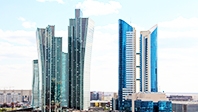March 11, 2013 – The Silk Road -- if that phrase evokes images of vibrant colors, rich fabrics, dusty, crowded markets, the heady smell of exotic spices, and the promise of adventure and travel to far flung cities – well, you are not alone.
For centuries, the Silk Road connected the Far East, Middle East, and Europe through a comprehensive network of land and sea routes. Cities emerged at key locations, helping traders travel and sell wares from jewels and fabrics, to perfumes and medicines. In Europe and Asia, particularly, cities evolved as a function of the Silk Road, linking the continents for trade. It later evolved as a product of Soviet planning, where a city’s location was based on transport efficiency, inter-regional equity, defense capacity, and in some cases, to colonize empty territory.
The breakup of the Soviet Union, along with the emergence of regional powers such as the European Union, China and India, and the return of the market as society’s driving force, have given rise to the need to rethink cities along the Eurasian Silk Road, according to a World Bank Group report called “Eurasian Cities – New Realities along the Silk Road.”
Five elements key to rejuvenating the Eurasian Silk Road are rethinking, planning, connecting, greening and financing cities, according to the report.
Rethinking cities
Take Kramatorsk in Ukraine, for example.
Its population shrank by 15 percent between 1989 and 2010 to 167,850. Its main employer was one of the largest heavy machinery plants in the Soviet Union, whose workforce fell from 40,000 to 14,000. Still, the city found ways to compensate. It modernized its infrastructure, capitalized on its proximity to the regional capital and the Russian border by exporting 40 percent of its output to the likes of the EU and Brazil, and compensated for jobs lost in the machinery plant by focusing on an emerging jewelry industry.
Kramatorsk illustrates that the network of cities from the Soviet era does not fit the region’s current and emerging economic needs, which are largely concentrated around Europe on one side and Asia on the other. Taking advantage of such market forces is essential in rethinking cities.
Planning plays a part
A city’s success is tied to how good its living conditions are and the quality of life it offers. Weak rental markets, misallocated housing stock, and absent or poorly enforced city planning regulations are issues that make a city inefficient and undesirable for urban dwellers. Collaboration between local and central governments to modernize land use regulations, solve property issues, and implement strategic public infrastructure can help avoid those problems.
Georgia managed to do it with its urban land use planning application system, as an example. The regulations now include a “single window” mechanism where documents need to be submitted only once, and if the applicant has not heard back from officials within a predetermined period, they are to assume that the application has been accepted.
Connectivity is key for cities
Take Georgia’s new highway to its Black Sea ports or a new railway to Turkey, for instance. Such massive projects would not be of significant use until neighboring countries see the collective economic benefit in cooperation and loosening their border restrictions.
Even within a country, good connectivity has the power to revive cities. Take Karaganda in Kazakhstan. A new two-lane road to the country’s capital Astana has cut travel time in half, and revived its dwindling population with the prospect of higher pay and plans to build leisure facilities in the city.
So, better interstate cooperation by managing borders better and by introducing less restrictive international aviation policies, encouraging competition in air transport markets and promoting information and communications technology can mean big economic gains.
Greening cities for urban growth
While the Soviet era encouraged the use of public transport and recycling, it also left significant industrial pollution and inefficient energy use, among other things, in its wake. Recently, while the focus has turned to energy efficiency and lowering pollution, cities still grapple with problems like the prolific use of cars and failing recycling systems. These have to improve for cities to be more environmentally friendly and attract a young, urban population who will play a key part in driving the economy in the future.
Kazan, in Russia, has done something like it. With its new city buses and high-speed trams that run on electricity, it promotes environmentally friendly public transportation and takes advantage of the focus on “green” initiatives, making living there attractive for a new wave of workers.
Flexibility in the financing model
The region is moving towards subnational financing, with transparent systems for revenue sharing and equalization transfers, though some countries are moving at a faster rate than others. Spending more on urban services can be financed by increasing local taxes, and housing maintenance fees and charges for water, heating, and public transport, helping finance other measures for cities.
Take Uzgen in the Kyrgyz Republic, for example. Careful analysis and advertising helped the town sell vacant land sites for almost five times the estimated market value, as land was packaged with little contractual uncertainties for investors, with limitations removed and a clear bidding process. The city now has a mixed use building with a supermarket and hotel.
While this is clearly not an overnight process, policy makers should recognize that they have a key role in driving the restructuring of these cities and in making them relevant in the current economy and going forward.

